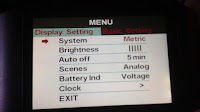But let's step back for a minute. My 750C has a bunch of settings as well. Different displays will be different. Some of these settings adjust the settings programmed into the motor controller, again depending what settings are in the controller.
By pushing the "Menu" button quickly twice, I access those settings and then navigate through them and set some of them. Here is are some screen shots:
They are pretty much self explanatory.
Then comes the fun part. Setting up each of the three tables that are loaded to configure the controller in the Penoff or M2.0 Programming software for the motor controller. I downloaded mine from the internet at :
https://penoff.wordpress.com/2016/01/13/e-bike-conversion-software/
You have to extract the zipped file. Includes the executable configuration tool, a help file, and some .el files which are the data files
To use the Penoff Configuration Software Tool, you connect the Communications Cable (from Luna) to the green plug coming from the BBSO2 motor to the display, Here:
 |
| Cable w green plug coming from BBSO2 to your display |
your computer and click connect. I use a Windows 10 Laptop w a USB 3.0 port. It worked without a hitch. Except once my Defender did not initially 'trust' the Penoff file and I had to overide its objections.
The first chore is to click 'Read' for Each of the three pages or 'Read Flash to to see what the current settings in the BBSO2. Then click 'File" and 'Save As' naming the file and storing the current settings to you computer for reference or to reinstall at a future date.
NOW you can 'Load' the desired new .el profile into the program. I loaded the 'JPLabs Relaxed' profile from my laptop. I had created a list of several profiles- .el files- from the comparison XLS Spreadsheet I had downloaded from Dropbox. Here is what the JPLabs populated configuration tool screens looked like:
Apologize for the quality of these picts. They were cell phone shots of my computer screen. At the top of each screen are the headings: "Basic" "Pedal Assit" and "Throttle Handle". You can readily see there are a lot of numbers and the descriptions of what each one will do is not readily evident. Don't blow your eyeballs trying to make out the numbers here, suffice to say you want to use the program to "load, populate, name and then save" a proper .el file. To transfer the date to the BBSO2 you simply click 'Write' for each individual page or click 'Write Flash' to transfer all three pages. It only takes a few seconds.
Finished? Click 'Disconnect', unplug your programming cable, replug your green cable end to your display, fire up your trike and off you go.
Transferring an .el file into the BBSO2 is perhaps a 5 to 10 minute job.
Preparing the .el files. Lots of thinking there particularly if you are starting from scratch.
So far I have run the stock Luna HotRod, Penov Standard, and JPLabs Relaxed Settings. I have been running them over a standard course about 27 km trying to maintain the same speeds 22-24 kph. JP Labs Relaxed is best so far for my trike, roads and legs. In Level 7 Assist in 6 and 7 gear it draws 25-50 watts once I attain cruising speed over 22kph. If I drop below that speed to 21 it will boost power up as high as 550w when I am climbing a hill, but not gearing down and under the 21 kph speed.
Acceleration at this level of assist in lower gears is quite strong, but the delay in applying power from a stop to start cranking is very soft giving ample time for shifts to complete. The Penoff settings were quite abrupt in this regard.
So I have lots of profiles to test and as I understand what some of the more obscure settings mean and will do I look forward to continuing the adventure.







No comments:
Post a Comment